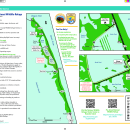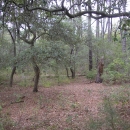Visit Us
National wildlife refuges offer us all a chance to unplug from the stresses of daily life and reconnect with our natural surroundings. Pea Island National Wildlife Refuge is a tiny piece of barrier island on the Outer Banks of North Carolina... small in size, but huge in popularity among both wildlife and people! Pea Island offers visitors the opportunity to experience spectacular flocks of ducks, swans, and other waterfowl, and explore dynamic beaches and dunes. Visitors can stop by the Visitor Center, hike one of the refuge trails, dip a fishing line in the surf or the sound, or relax by the beach.
Activities
While visiting the Outer Banks, venture to Pea Island National Wildlife Refuge, a hot spot for both birds and birders. Drop by the Visitor Center to view displays on local wildlife. Then, try out one of the scopes trained on North Pond to view various species of birds found there. The best birding is during the fall and winter, when thousands of migratory ducks, geese, and swans rest and refuel on the refuge.
There are two short, universally accessible wildlife trails on Pea Island. The half-mile one-way North Pond Wildlife Trail starts near the Visitor Center and terminates at a two level tower which offers spectacular views of the surrounding ponds. The Salt Flats Wildlife Trail is shorter and located on the north end of North Pond, terminating at a disabled-accessible overlook providing views of the Salt Flats area and North Pond. There is also a service road that completely encircles North Pond, and visitors may choose to walk the whole route, though thorny vegetation, insect activity, and traffic along the portion on Highway 12 make this less enjoyable for some.
During the summer, join refuge staff for our sea turtle talk or a canoe tour!
Trails
Pea Island National Wildlife Refuge offers three trails that are open year-round during daylight hours. The two wildlife trails have several elevated platforms for wildlife viewing. All trails are relatively flat.
Related Documents
Other Facilities in the Complex
The refuge is managed as part of the Coastal North Carolina National Wildlife Refuge Complex. A National Wildlife Refuge Complex is an administrative grouping of two or more refuges, wildlife management areas or other refuge conservation areas that are primarily managed from a central office location. Refuges are grouped into a complex structure structure
Something temporarily or permanently constructed, built, or placed; and constructed of natural or manufactured parts including, but not limited to, a building, shed, cabin, porch, bridge, walkway, stair steps, sign, landing, platform, dock, rack, fence, telecommunication device, antennae, fish cleaning table, satellite dish/mount, or well head.
Learn more about structure because they occur in a similar ecological region, such as a watershed or specific habitat type, and have a related purpose and management needs.
There are 9 national wildlife refuges in the Coastal North Carolina National Wildlife Refuges Complex. The Project Leader for the Complex supervises the Refuge Managers who are responsible for managing these refuges. However, there are five distinct and separate administrative offices. Alligator River and Pea Island National Wildlife Refuges are administered from the Alligator River National Wildlife Refuge Headquarters in Manteo, NC. An administrative office at the Mackay Island National Wildlife Refuge Headquarters in Knotts Island, NC manages both Mackay Island and Currituck National Wildlife Refuges. An office at Mattamuskeet National Wildlife Refuge administers Mattamuskeet, Swanquarter, and Cedar Island National Wildlife Refuges. Pocosin Lakes National Wildlife Refuge, Roanoke River National Wildlife Refuge, Great Dismal Swamp National Wildlife Refuge, Back Bay National Wildlife Refuge, and Edenton National Fish Hatchery each have separate administrative offices.
All of the Coastal North Carolina National Wildlife Refuges, Great Dismal Swamp National Wildlife Refuge, Back Bay National Wildlife Refuge, and Edenton National Fish Hatchery are open to public visits for nature-based recreational enjoyment. Priority public uses are hunting, fishing, wildlife observation, wildlife photography, environmental education, and interpretation.
Locations



















Stop by the Visitor Center to explore hands-on exhibits about the wildlife and habitats of the barrier island systems; pick up a map and information about refuge trails and activities; and look through the scopes at birds and wildlife using North Pond.
Driving access is via North Carolina Highway 12, which passes through the refuge.
The refuge Visitors Center is approximately four miles south of the Basnight Bridge over Oregon Inlet and approximately eight miles north of Rodanthe.
In addition, there are several parking areas off of NC Highway 12 that provide access for Oregon Inlet, the Salt Flats Wildlife Trail, and the North Pond Photo Blind. Parking off the shoulders of NC Highway 12 (within the right-of-way) is allowed unless otherwise posted, but be warned that the sand can be very soft. Stuck vehicles are a near-daily occurrence.





